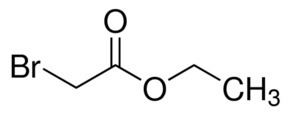Density 1.51 g/cm³ Molar mass 167.01 g/mol Melting point -38 °C | Boiling point 158 °C Formula C4H7O2Br | |
 | ||
Related compounds Appearance Colorless to yellow liquid | ||
Ethyl bromoacetate is the chemical compound with the formula CH2BrCO2C2H5. It is the ethyl ester of bromoacetic acid and is prepared in two steps from acetic acid. It is a lachrymator and has a fruity, pungent odor. It is also a highly toxic alkylating agent and may be fatal if inhaled.
Applications
In World War I, ethyl bromoacetate was used as a lachrymatory agent and tear gas agent for chemical warfare under the German code Weisskreuz (White Cross), and later as odorant or warning agent in odorless, toxic gases. It is listed by the World Health Organization as a riot control agent, and was first employed for that purpose by French police in 1912. The French may have employed gas grenades of this substance in 1914 during World War I. The German army then used this attack to justify their subsequent employment of chemical weapons in 1915.
In organic synthesis, it is a versatile alkylating agent. Its major application involves the Reformatsky reaction, wherein it reacts with zinc to form a zinc enolate. The resulting BrZnCH2CO2Et condenses with carbonyl compounds to give a β-hydroxy-esters.
It is also the starting point for the preparation of several other reagents. For example, the related Wittig reagent (prepared by reaction with triphenylphosphine) is commonly used to prepare alpha,beta-unsaturated esters from carbonyl compounds such as benzaldehyde:
